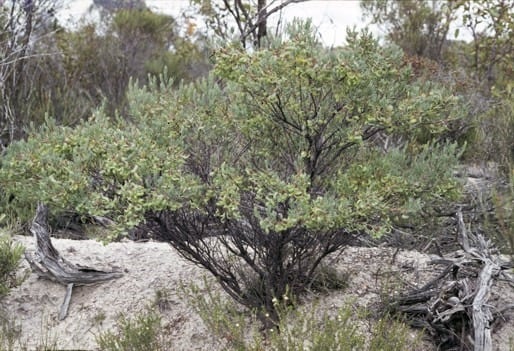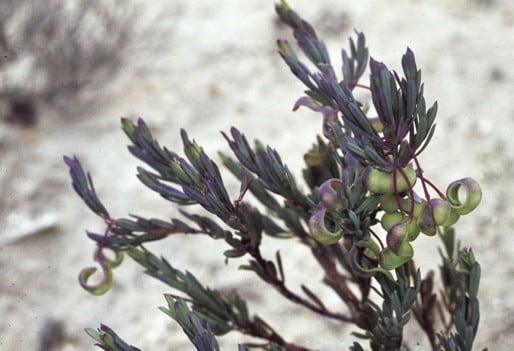Acacia diaphyllodinea Maslin
WATTLE
Acacias of Australia
Family
Fabaceae
Distribution
Occurs from Lake Varley and Frank Hann Natl Park S to about Ravensthorpe, south-western W.A.
Description
Spreading glabrous shrub 0.3–0.7 m high. Phyllodes ascending to erect, narrowly oblong to oblong-oblanceolate, horizontally flattened, planoconvex when narrow, 8–15 mm long, 2–3.5 mm wide, apiculate, scarcely thickened, normally shallowly concave above when dry, green to subglaucous (new growth glaucous with youngest phyllodes tinged purple); midrib (on lower surface) evident, slightly raised when dry; marginal nerves evident; gland on upper surface near or above middle of phyllode, commonly absent. Inflorescences rudimentary 2-headed racemes with axes > 0.5 mm long; peduncles 5–8 mm long, recurved in fruit; basal bract rostriform and 2–2.5 mm long; heads globular, ±4 mm diam., 13–15-flowered, golden. Flowers 5-merous; sepals free. Pods narrowly oblong, curved in suture plane, ±circinnate or sigmoid, to 4 cm long, 5–7 mm wide, thinly coriaceous-chartaceous, lightly pruinose. Seeds oblique, ovate, c. 3 mm long, mottled brown; aril subterminal.
Habitat
Grows in gravelly sand, mostly in low heath and low shrubland.
Specimens
W.A.: Lake Varley, P.E.Conrick 1584 (PERTH); 38.5 km E of Lake King store on road to Peak Charles, B.R.Maslin 5781 (CANB, K, PERTH); Frank Hann Natl Park, D.Monk 26 (PERTH).
Notes
This species, together with A. binata and A. crassuloides, comprise the ‘A. diaphyllodinea group’. All three species have horizontally flattened phyllodes (i.e. diaphyllodes) with a gland situated on their upper surface. In other Acacia species with flat phyllodes the lamina is flattened in the vertical plane and the gland is situated on its upper margin. Diaphyllodes, which occur also in A. basedowii, A. binata, A. blakelyi, A. crassuloides, A. ericifolia, A. leptospermoides, A. oxyclada, A. spathulifolia, A. sulcata and A. vassalii, are considered to have arisen independently in a number of unrelated subgroups of section Phyllodineae, fide J.Vassal, Bull. Soc. Hist. Nat. Toulouse 118: 125–130 (1982). This unusual phyllode type is also discussed in J.Vassal & B.R.Maslin, Bull. Soc. Hist. Nat. Toulouse 115: 393–401 (1979) and J. Vassal, Bull. Soc. Bot. France, Actual Bot. 126(3): 55–65 (1979).
Most closely related to A. crassuloides; also allied to A. binata.
FOA Reference
Data derived from Flora of Australia Volumes 11A (2001), 11B (2001) and 12 (1998), products of ABRS, ©Commonwealth of Australia
Author
B.R.Maslin
This identification key and fact sheets are available as a mobile application:
URL: https://apps.lucidcentral.org/wattle/
© Copyright 2018. All rights reserved.











